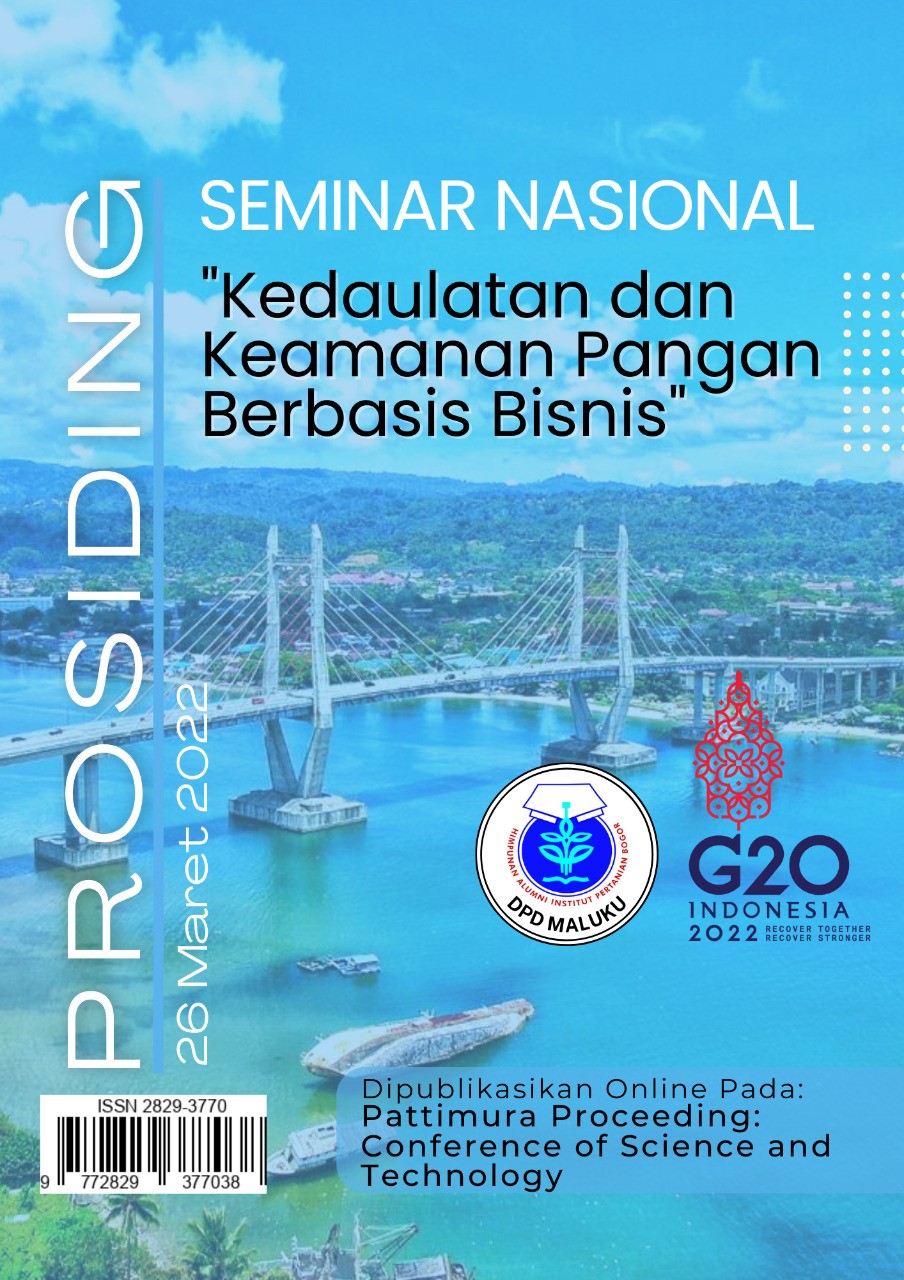PENANGKAPAN TUNA MADIDIHANG (THUNNUS ALBACARES) DENGAN PANCING ULUR OLEH NELAYAN KECAMATAN AMAHAI KABUPATEN MALUKU TENGAH
Catching of Madidihang Tuna (Thunnus albacares) Fishing Lines by Fishers in Amahai District, Central Maluku Regency
Abstract
One of the fishery commodities with high economic value is tuna, where in the Maluku region in 2021, tuna production will be 35.56% (BPS, 2022). Tuna is caught using handlines which are classified as small-scale fisheries. The existence of tuna that changes over time causes fishermen to experience uncertainty in finding suitable fishing areas. Temperature is an important indicator in the distribution and abundance of tuna. This study aims to determine the composition of the hand line catch and to analyze the temperature distribution based on the area of the hand line fishing operation in Central Maluku Regency. The research was conducted in the waters with the method used is a survey method by following fishing trips and using GPS satellite-based Spot Trace to track vessel movement activities during fishing operations. Descriptive data analysis was used to determine the composition of fisherman catches and used SeaWiFS Data Analysis System (SEADAS) 7.3.1 and Surfer 12 to analyze the distribution of water temperatures at fishing locations. The results showed that yellowfin tuna (Thunnus albacares) dominated the catch by 70.30%, bigeye tuna (Thunnus obesus) by 20.19% and skipjack tuna (Katsuwonus pelamis) by 0.52%. The frequency distribution of yellowfin tuna length ranges from 23-171 cmFL where during 2019 it was dominated by sizes <100 cmFL as much as 82.42%. The SST range in January is 290C-310C, optimal fishing is at 29.80C-30.40C, April is in the range of 30.20C-31.70C, optimal fishing is at 30.90C-31.30C, in May is in the range of 27.40C-31,40C the optimal catch is in the temperature range of 27.80C -30.80C, in June is 27.40C -280C the optimal catch is in the temperature range 27.60C-27.850C, in September 27.40C-29.50C the optimal catch is at a temperature range of 27, 80C -28.50C, and in December the range of 29.40C-31.50C is optimal for catching at a temperature range of 30.40C -31.20C
Downloads
References
Doddema, M., Spaargaren, G., Wiryawan, B., & Bush, S. R. 2018. Fisher responses to private monitoring interventions in an Indonesian tuna handline fishery. Fisheries Research, 208, 49-57.
[FAO] Food and Agricultural Organization. 2008. The State of the World Fisheries and Aquaculture. Rome: Food and Agriculture Organization.
Jalali MA, Ierodiaconou D, Monk J, Gorfine H, and Rattray A. 2015. Predictive mapping of abalone fishing grounds using remotely-sensed LiDAR and commercial catch data. Journal of Fisheries Research 169(1):26–36.
Kantun, W., S.A.Alam, A.Mallawa, dan A.Tuwo, 2011. Ukuran Pertama Kali matang Gonad dan Nisbah Kelamin Tuna Madidihang Thunnus albacares di Perairan Majene Selat Makassar. Jurnal Balik Diwa. Vol 2 (2) ISSN 2086-7530.
Meza, E.B and S.O. Gracia. 2003. Spatial and Temporal Variation of Yellowfin Tuna Set Associated with Spotted Dolphin and their Relationship with Sea Suaface Temperature. Proceedings of the 54th Annual Tuna Conference Lake Arrowhead, California, May 13-16 2003.
Mundy, C.N. 2012. Using GPS technology to improve fishery dependent data co-llection in abalone fisheries. Univers-ity of Tasmania. Tasmania. 122p.
Nootmorn, P., A. Yakoh, and K. Kawises, 2005. Reproductive biology of yellowfin tuna in the eastern Indian Ocean. http://www.iotc.org/files/proceedings/2006/wptt/IOTC-2005-WPTT-14.pdf.
Rivai, Andi Alamsyah., dkk. 2017. Pemetaan Daerah Potensial Penangkapan Ikan Menggunakan Pendekatan Model GIS HOTSPOT dan Analisis Time Series Studi Kasus Pada Perikanan Bagan Perahu Di Kepulauan Seribu. Jurnal Ilmu dan Teknologi Kelautan Tropis, Vol. 9, No. 1, Hlm. 337-356, Juni 2017.
Safruddin, M. Zainuddin dan C. Rani. 2014. Prediksi Daerah potensial penangkapan Ikan Pelagis Besar Di Perairan Kabupaten Mamuju. Jurnal IPTEKS Pemanfaatan Sumberdaya Perikanan, Vol.1 (2): 185-195. ISSN: 2355-729X.
Simbolon, D. (2019). Suatu Studi tentang Potensi Pengembangan Sumberdaya Ikan Cakalang dan Teknologi Penangkapan Ikan yang Ramah Lingkungan. Bul FPIK IPB, 13(1), 48–67.
Tawari R.H.S, Simbolon D, Haruna, 2019. Productivity of Small-Scale Yellowfin Tuna Fishing in West Region of Ceram District, Moluccas Province, Indonesia. International Journal of Environment, Agriculture and Biotechnology (IJEAB) Vol-4, Issue-5, Sep-Oct- 2019 https://dx.doi.org/10.22161/ijeab.45.25 ISSN: 2456-1878.
Wudji A, Suwarso dan Fauzi M. 2014. Karak-teristik Perikanan Jaring, Daerah Pe-nangkapan dan Hasil Tangkapannya di Laut China Selatan. Prosiding Simposi-um Nasional Pengelolaan Perikanan Tu-na Berkelanjutan. Hal 61-69.
Zhu, G., L.Xu, Y.Zhou, Song, L., 2008. Reproductive biology of yellowfin tuna T. albacares in the west-central Indian Ocean. Journal of Ocean University of China (English Edition) 7: 327-332
Copyright (c) 2022 Pattimura Proceeding: Conference of Science and Technology

This work is licensed under a Creative Commons Attribution-NonCommercial-ShareAlike 4.0 International License.












